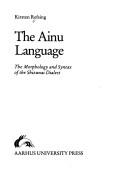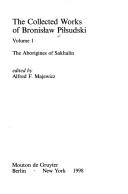| Listing 1 - 3 of 3 |
Sort by
|

ISBN: 8772880201 Year: 1986 Publisher: Aarhus Aarhus university press
Abstract | Keywords | Export | Availability | Bookmark
 Loading...
Loading...Choose an application
- Reference Manager
- EndNote
- RefWorks (Direct export to RefWorks)
809.56 --- J5091 --- J5028 --- Ainu language --- -Ainu language --- -Aino language --- Hyperborean languages --- Japans --- Japan: Language -- minority languages in Japan -- Ainu --- Japan: Language -- dialects and variation -- Hokkaidō and Northern territories --- -Japans --- 809.56 Japans --- -809.56 Japans --- Aino language --- Morphology --- Syntax --- Morphology. --- Syntax. --- Aïnou (langue) --- Aïnou (peuple d'asie) --- Histoire --- Acculturation --- Dialectes --- Grammaire --- Japon
Book

ISBN: 9781501502859 9781501510885 9781501502873 Year: 2022 Publisher: Berlin Boston
Abstract | Keywords | Export | Availability | Bookmark
 Loading...
Loading...Choose an application
- Reference Manager
- EndNote
- RefWorks (Direct export to RefWorks)
The volume is aimed at preserving invaluable knowledge about Ainu, a language-isolate previously spoken in Hokkaido, Sakhalin, and Kurils, which is now on the verge of extinction. Ainu was not a written language, but it possesses a huge documented stock of oral literature, yet is significantly under-described in terms of grammar. It is the only non-Japonic language of Japan and is typologically different not only from Japanese but also from other Northeast Asian languages. Revolving around but not confined to its head-marking and polysynthetic character, Ainu manifests many typologically interesting phenomena, related in particular to the combinability of various voice markers and noun incorporation. Other interesting features of Ainu include vowel co-occurrence restrictions, a mixed system of expressing grammatical relations, which includes the elements of a rare tripartite alignment, nominal classification distinguishing common and locative nouns, elaborate possessive classes, verbal number, a rich four-term evidential system, and undergrammaticalized aspect, which are all explained in the volume. This handbook, the result of unprecedented cooperation of the leading experts of Ainu, will definitely help to increase the clarity of our understanding of Ainu and in a long-term perspective may provide answers to problems of human prehistory as well as open the field of Ainu studies to the world and attract many new students. Table of Contents Masayoshi Shibatani and Taro KageyamaPreface Masayoshi Shibatani and Taro KageyamaIntroduction to the Handbook of Japanese Language and Linguistics Contributors Anna BugaevaIntroduction I Overview of Ainu studies Anna Bugaeva1. Ainu: A head-marking language of the Pacific Rim Juha Janhunen2. Ainu ethnic origins Tomomi Satō3. Major old documents of Ainu and some problems in the historical study of Ainu Alfred F. Majewicz4. Ainu language Western records José Andrés Alonso de la Fuente5. The Ainu language through time Alexander Vovin6. Ainu elements in early Japonic Hidetoshi Shiraishi and Itsuji Tangiku7. Language contact in the north Hiroshi Nakagawa and Mika Fukazawa8. Hokkaido Ainu dialects: Towards a classification of Ainu dialects Itsuji Tangiku9. Differences between Karafuto and Hokkaido Ainu dialects Shiho Endō10. Ainu oral literature Osami Okuda11. Meter in Ainu oral literature Tetsuhito Ōno12. The history and current status of the Ainu language revival movement II Typologically interesting characteristics of the Ainu language Hidetoshi Shiraishi13. Phonetics and phonology Hiroshi Nakagawa14. Parts of Speech – with a focus on the classification of nouns Anna Bugaeva and Miki Kobayashi15. Verbal valency Tomomi Satō16. Noun incorporation Hiroshi Nakagawa17. Verbal number Yasushige Takahashi18. Aspect and evidentiality Yoshimi Yoshikawa19. Existential aspectual forms in the Saru and Chitose dialects of Ainu III Appendices: Sample texts Anna Bugaeva20. An uwepeker “Retar Katak, Kunne Katak” and kamuy yukar “Amamecikappo” narrated in the Chitose Hokkaido Ainu dialect by Ito Oda Elia dal Corso21. “Meko Oyasi”, a Sakhalin Ainu ucaskuma narrated by Haru Fujiyama Subject index
Language and languages. --- Ainu language. --- Language and languages --- Foreign languages --- Languages --- Anthropology --- Communication --- Ethnology --- Information theory --- Meaning (Psychology) --- Philology --- Linguistics --- Aino language --- Hyperborean languages --- Phonology. --- Anthropology. --- East Asian Studies. --- Japanese Studies. --- Language Description/Documentation. --- Linguistic Typology. --- Sociolinguistics. --- Ainu language --- Phonology --- J5091 --- Japan: Language -- minority languages in Japan -- Ainu --- Japanese language

ISBN: 311010928X 3110161184 3110176149 9783110221053 3110221055 Year: 1998 Publisher: Berlin Mouton de Gruyter
Abstract | Keywords | Export | Availability | Bookmark
 Loading...
Loading...Choose an application
- Reference Manager
- EndNote
- RefWorks (Direct export to RefWorks)
Volume 4 includes unique records of Orok (Uilta), a Tungusic language (dictionaries, texts, grammatical comments) noted down by Pilsudski directly from native informants at the beginning of the 20th century on Sakhalin. The original source material is identified with the help of - and confronted against - all the existing contemporary dictionaries with the assistance of leading specialists in the field (the Novosibirsk Avrorin group, also called the school of Manchu-Tungusologists). Abundant comparative data are quoted. All necessary introductory information and commentaries of ethnographic, h
Ethnology. Cultural anthropology --- Russian language --- Russia --- Tungus-Manchu languages. --- Tungusic peoples --- Altaic peoples --- Ethnology --- Manchu languages --- Manchu-Tungus languages --- Tungus languages --- Tungusic languages --- Altaic languages --- Social life and customs. --- J5091 --- J4207 --- J4190.80 --- J4190.85 --- Japan: Language -- minority languages in Japan -- Ainu --- Japan: Sociology and anthropology -- communities -- native ethnicity and race --- Japan: Sociology and anthropology -- local communities and culture -- Hokkaidō (Ezo) --- Japan: Sociology and anthropology -- local communities and culture -- northern territories --- Endangered Languages. --- Language Contact. --- Non-Indo-European Languages.
| Listing 1 - 3 of 3 |
Sort by
|

 Search
Search Feedback
Feedback About UniCat
About UniCat  Help
Help News
News